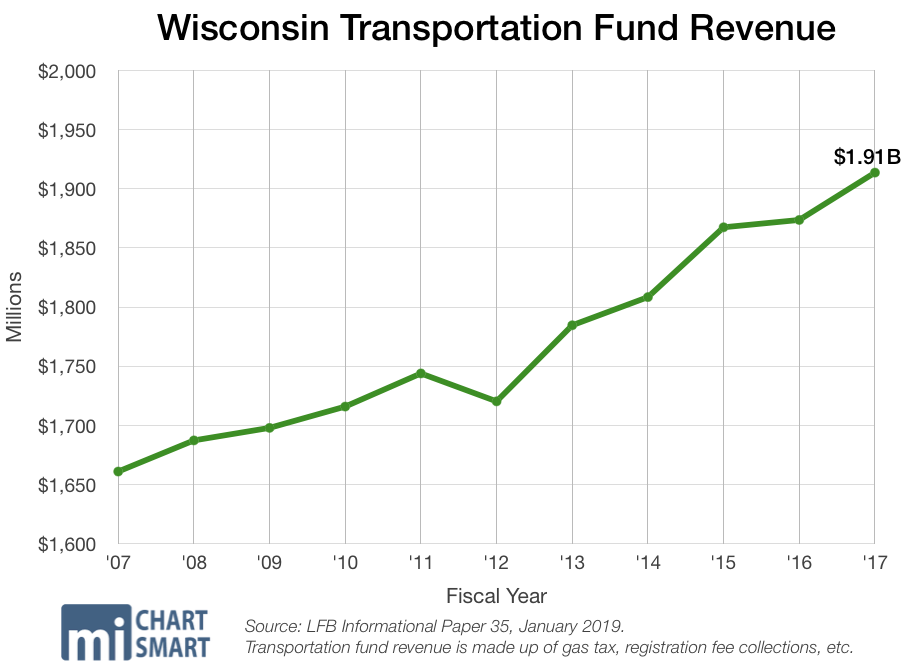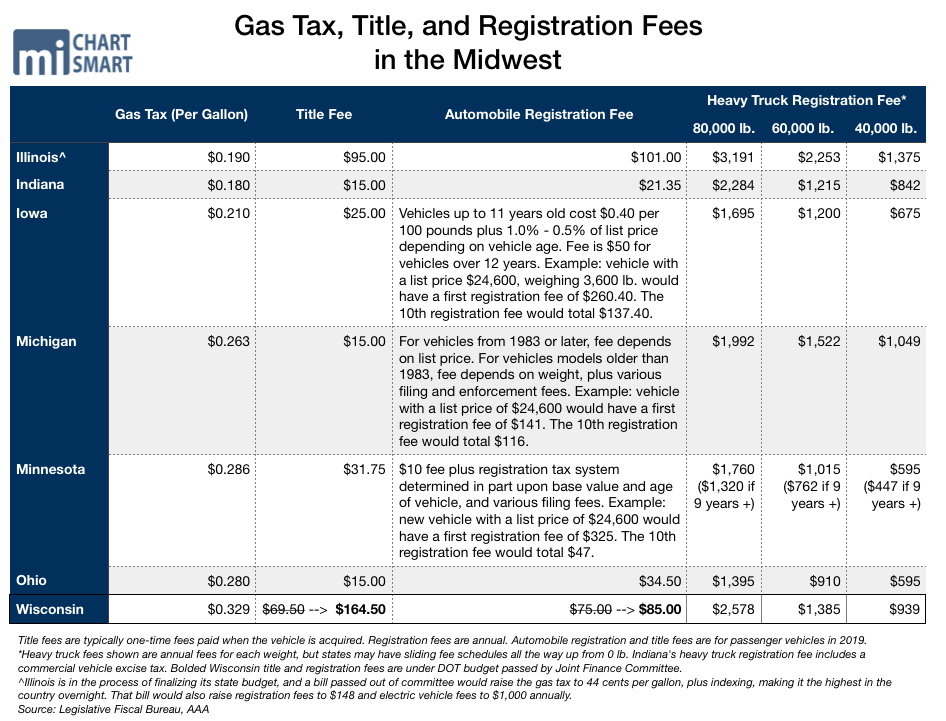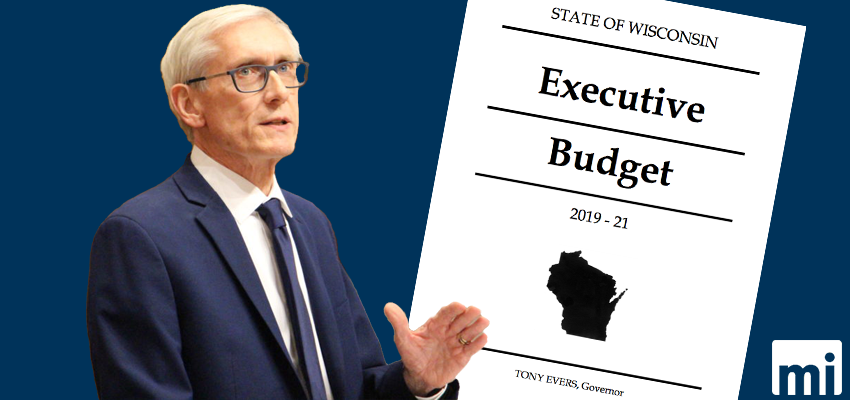
Read our complete budget analysis here.
[bctt tweet=”Something for everyone to love and hate; No reforms, but disasters avoided; Tax cuts, but spending hikes. MacIver analyzes the 2019-21 state #wibudget; #wiright #wipolitics” username=”MacIverWisc”]Disasters avoided, the reform(less) budget, unneeded spending increases all across the board, and the march to a flatter, fairer tax code
Something for everyone to hate in this budget, something for everyone to love in this budget
July 9, 2019
A MacIver Institute Analysis
The 2019-21 Wisconsin state budget is now law. After months of debate, numerous public hearings, countless hours making its way through committee, dozens of amendments voted on and almost 80 vetoes, Assembly Bill 56, the state budget bill, has been signed into law by Governor Tony Evers and is now 2019 Wisconsin Act 9.
There is something for everyone to love in this budget – from fiscal conservatives, far-left progressives, Republicans, taxpayers, Democrats, big-government loving special interests, lobbyists, to local governments – and something in this budget for everyone to hate.
That makes this budget different than any other budget in recent memory. It really should come as no surprise, however, given the fact that we have divided government with Democrat Tony Evers as governor and both houses of the Legislature comfortably controlled by Republicans.
Disasters Avoided – Big Labor, The Big Loser
To fully understand how we got to this place, you have to start at the beginning when Evers introduced his budget proposal in late February.
Evers’ budget proposal wasn’t just a big liberal wish list, but a radical progressive’s best dream.
Simply put, Evers introduced the most irresponsible and anti-taxpayer budget in recent memory.
Assembly Speaker Robin Vos (R-Rochester) described the Evers budget as a “big liberal wish list.” Looking at the expansive list of progressive policies that vastly grow the size and scope of government, it is hard to argue with that description.
From Medicaid expansion, the end of recent welfare work requirements, an unneeded increase in the state’s minimum wage, a green pipe dream to make the state carbon-free, the creation of many new government programs, an assault on proven education reform programs, the decriminalization of small amounts of marijuana, to the end of the property tax freeze — the budget wasn’t just a big liberal wish list, but a radical progressive’s best dream. As proposed, Evers’ budget would have also:
- Hiked the gas tax and tied it to inflation, for a total gas tax increase of nearly 10 cents per gallon
- Raised taxes on job-creating manufacturers by limiting the Manufacturing and Agriculture Tax Credit
- Raised taxes on retirees by ending a long-term capital gains tax exemption
- Repealed the state’s right-to-work law
- Restored the state and local prevailing wage
- Rolled back tax protections that have led to a property tax freeze, giving local units of government more power to raise property taxes
- Frozen enrollment in school choice programs
- Ended the Special Needs Scholarship Program
- Stopped new independent charter schools from opening until 2023
- Raised the minimum wage to $8.25 in 2020, followed by annual 75-cent increases until it reaches $10.50 in 2023, then tying it to inflation and creating a task force to study how to get to a $15 per hour minimum wage for everyone
- Raised the minimum wage for government workers to $15 per hour in 2021
- Spent $5 million to provide internet access for welfare recipients
- Eliminated work requirements for able-bodied adults with school-aged dependents
- Eliminated drug testing for most public assistance programs
- Created a new statutory goal for a minimum broadband speed across the state
- Tied revenue limits for school districts to inflation
- Deferred to agency rules and guidance documents, bypassing the Legislature and broadening the powers of the administrative state
- Created a $2 billion structural deficit while raising general fund taxes by $1.3 billion, and local property taxes by untold millions more
- And much, much more…
Thankfully, the Republican-led Joint Finance Committee (JFC) quickly removed all of these disasters. In its first executive session on the budget, it stripped out 131 policy items and more than $1 billion in tax increases. Almost every single big-government provision – except for gas tax indexing – was pulled out in JFC’s first budget action.
As we examine the final product today, it is important that we take time to remember how bad Evers’ original budget was and give Republicans credit for removing all of this bad public policy.
Medicaid expansion would have devastated health care affordability for the average Wisconsinite, pushing up premiums and severely limiting access to care. Low-income individuals who currently have subsidized, private plans for cents on the dollar would be forced onto a government plan with less access to providers and worse health outcomes. It would also push thousands more Wisconsinites onto a system that is already struggling to stay sustainable – just 2.6 Wisconsin workers support each Medicaid recipient today. In 1998, 7.2 workers supported each recipient. As it stands, Medicaid already has a serious math problem. Pushing enrollment even higher would only make health outcomes, access, and the program’s cost worse.
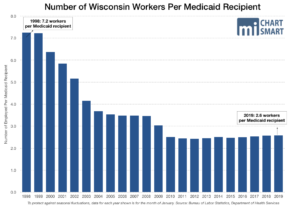

If you are still not sure if Medicaid expansion is a bad idea, just look at the states that have accepted it and what a financial hardship it has been for those states. Medicaid spending in Ohio, for example, skyrocketed 35 percent in four years – from $18.9 billion to $25.7 billion between fiscal year 2013 and 2017.
In Arizona, costly visits to the emergency room have jumped more than 300 percent and providers have shifted an additional $700 million in costs onto private plans after the Medicaid expansion. In Rhode Island, Medicaid enrollment ballooned 63 percent and state spending on the program has increased 25 percent since expansion, forcing the state to consider a new payroll tax on employers.

It also would expand welfare in a time of unprecedented economic growth. The final budget delivers substantial increases in health care and medical assistance funding without using money from a debt-ridden federal government that has failed to keep funding promises to states.
Those are among the many reasons why Republicans fought so hard to keep the idea out of the budget.

The same can be said of Republicans’ defense of worker freedom.
It’s no secret that Big Labor targeted Gov. Walker as public enemy number one and made removing him from office its number one priority in the entire country. No one should have been surprised when Evers’ first budget proposal handsomely rewarded his Big Labor allies with a full-out assault on worker freedom and the taxpayer.
Evers proposed bringing back Big Labor’s favorite trifecta: repealing right-to-work, reinstating the prevailing wage law, and forcing large public works construction projects to use project labor agreements.
Wisconsin’s previous prevailing wage statute, which arbitrarily and unnecessarily tied wages on taxpayer-funded construction projects to inflated rates paid by unions, was repealed for local and state projects by Gov. Walker. Without interference from the government, wages are set by the market and driven by competition, saving Wisconsin taxpayers millions of dollars. Remember the case of the Grafton water tower?

Evers’ budget also would have eliminated Wisconsin’s right-to-work law. It’s called right-to-work precisely because it prohibits private-sector labor organizations from making compulsory union dues a condition of employment. Wisconsin workers have shown, en masse, that they don’t want to join unions: active membership in the National Education Association fell by 42 percent from 2013 to 2018. The percent of Wisconsin workers who belong to a union fell from 15 percent in 2008 to 8.1 percent in 2018.
Simply put, if unions provided a service that members thought was worthy, such dramatic drop-offs would not have occurred. Clearly, workers are voting with their feet and they are voting that they do not need unions.
Evers’ budget would have reinstated project labor agreements (PLAs) for public works projects. Local governments, beholden to Big Labor, use PLAs to stipulate that only union firms can bid on a project, shutting out competition and dramatically increasing the cost of projects that taxpayers pay for.
Ultimately, much of what makes the 2019-21 budget a good document is marked by what’s not in it. That is thanks to Republicans and their willingness to stand up to Big Labor and the far left. That also makes Big Labor the unquestioned big loser of the 2019-2021 state budget debate.
Finally, we would be remiss to not mention one last issue left untouched in the 2019-21 budget: Act 10. Walker’s signature 2011 reform was repeatedly slammed by the now-governor on the campaign trail and in years past. Nowhere does the budget roll back taxpayer protections created by the law, including increased contribution levels for public sector employee benefits or annual union recertification votes. For the taxpayer, that is a major disaster averted.
A Fiscal Arms Race – Making Everyone But The Taxpayer Happy
There’s no way around it: this budget spends a lot of money. When Evers released his budget plan in late February, Republicans slammed the new governor for spending far more than the state could afford. Yet, in the end, Republicans backtracked on the fiscal austerity rhetoric and in many cases, ended up spending a lot more than what was necessary.
In what can only be called a great disappointment for taxpayers, legislative Republicans decided in many instances to spend more than they have in recent memory and in some cases, spend more than Evers’ original proposal.
Evers had proposed increasing total government jobs by 701 full-time positions over the biennium. That would have brought the total number of all-funds state positions to 71,990.57 in 2020. JFC’s plan increased total positions by 482, up to 71,771.59 by 2020. That’s still a sizable increase. Plus, this budget gives all state employees 2 percent raises in each year of the biennium, and by constantly adding to state rolls, those types of increases will only be more expensive in the future.
In what can only be called a great disappointment for taxpayers, legislative Republicans tried to keep up with the liberals when it came to government largess. In some cases, they even outdid Evers’ original spending proposals. Prison guards, personal care workers, nursing homes, and Family Care direct care workers get considerably more funding than Evers requested.

Taxpayers should also question the wisdom of pumping $655.4 million more GPR into the status quo educational system that fails too many children and is experiencing flat enrollment. In this biennium, state support to K-12 schools will reach more than $14 billion, and DPI’s total budget spends north of $15.2 billion. Evers had proposed a $1.6 billion increase for the agency he headed until January, including more than $600 million to increase special education categorical aids. The final budget sends $330 million more into the equalization aid formula and $97 million more for special education categorical aids, along with a litany of other changes.
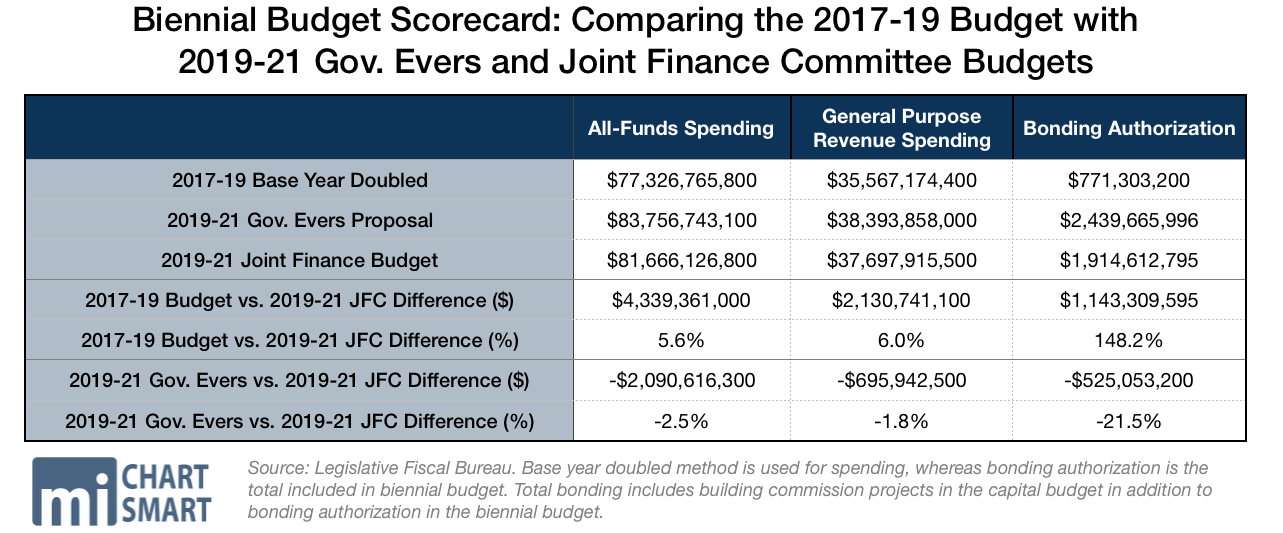
Still, JFC rejected the vast majority of Evers’ proposed changes to the school funding formula, such as adding another weight for impoverished students (counting them as 1.2 pupils instead of 1.0 for funding purposes). That led Evers’ supporters to slam the education plan, calling it a “$900 million cut.”

Only in Madison and the fantasy land of the nonsensical progressive is a $655 million increase in spending described as a cut.
Lost in this debate is the fact that Wisconsin’s K-12 population has stayed relatively flat for many years. If we are not experiencing a huge influx of new elementary kids to educate, why do our schools need $600 million in new funds? And this $600 million increase is on top of the $600 million increase included in the 2017-2019 state budget. Over a billion dollars in new funding to educate the same number of kids? Are we seeing any noticeable return on our increased investment?
Also lost in this debate is the fact that more and more families are choosing other educational choices outside of the public education system. Choice, charter and home schooling are all growing in popularity. That’s no surprise given that statewide English proficiency sits at just 44 percent, and math proficiency at 41 percent.
The K-12 educational system has continually failed many Wisconsin students, with thousands of new UW freshmen requiring remedial math or English. Those classes come with zero credit and the cost of full tuition, putting students behind before they even begin. Plus, many of these are students who were told they were doing well in school. More than half of Wisconsin’s five-star high schools sent more than 1,000 students who needed math remediation to UW.

And when just 54 percent of our public education dollars reach the classroom, we must ask how hundreds of millions of dollars will improve student achievement? For their part, legislative Republicans acknowledged the system is broken. But they didn’t take the opportunity to couple a significant funding increase with required better outcomes and meaningful systematic reform.
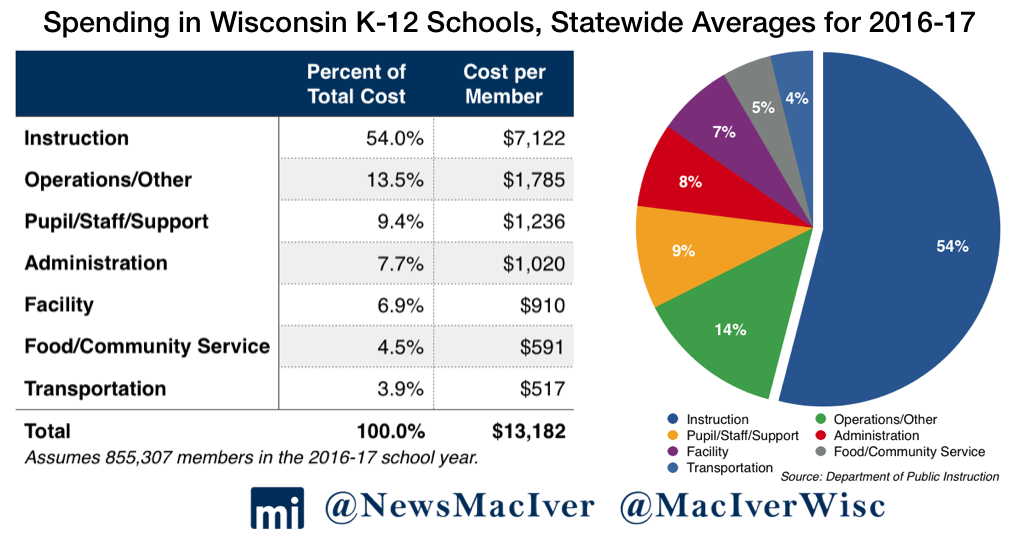
The same can be said for the UW System and the $220 million more it received compared to the last budget. Like the K-12 system, enrollment at UW has slowly fallen over the years. With a strong economy and record-low unemployment, young people now know that the math has changed. It’s no longer a given that taking on tens of thousands of dollars in student debt will pay off in the long run, and enrollment trends reflect that.
Still, the capital budget sends over $1 billion in new funding for building projects across the UW System. Numerous campuses, like UW-Eau Claire and UW-Milwaukee, will get brand new buildings, and every campus will see millions more in improvement projects.

Before the JFC vote on the capital budget, finance Co-Chair John Nygren (R-Marinette) spoke passionately on how broken the system is. He lamented that taxpayers pay UW lobbyists that then lobby the state for more money. He also lambasted the fact that UW officials are the drivers of new projects, setting rates and budgets for new buildings, knowing that the Legislature usually just goes along with the plan.
Nygren is exactly right on this – but he and every other JFC Republican voted for the package. It’s refreshing to see legislators make strong arguments at the table. But it’d be more refreshing if they would actually pass the reforms they say they want.
The health care debate brought a similar tone. Republicans held strong in refusing to expand Medicaid, but they instead agreed to send $1.6 billion in all funds to DHS. Of that increase, $917 million (all funds) is the cost-to-continue price tag for the state’s massive Medical Assistance programs.
Rather than pursuing innovative reforms in taxpayer-provided health care programs like direct primary care, self-funded association health plans, limited duration health plans, and dental therapy, JFC pumped more money into the Medicaid system they acknowledge is broken.
Too many politicians are content just throwing more money at these programs and these problems without addressing the fundamental causes of these problems and without making needed reforms to these programs.
Like so many other parts of the state budget, the new, incredibly generous funding for DHS came with little-to-no reforms attached. For taxpayers, this is frustrating and a huge missed opportunity to make Wisconsin a better place to live. Too many politicians are content just throwing more money at these programs without addressing the fundamental causes of the problems and without making needed reforms to these programs.
The Reform(less) Budget
As we’ve written above, on issues from K-12 education, Medicaid, higher education, welfare reform to the capital budget, legislators enacted few reforms to go along with the billions more in new spending they provided. One possible reason for this missed opportunity: Evers has the most powerful line item veto in the country. The majority of the few reforms contained in this budget were predictably vetoed out by the governor.
Nevertheless, it’s crucial that both sides fight for their beliefs and make their positions known. Taxpayers deserve an honest and genuine debate about the direction of our great state. If the capital building program is clearly broken, what’s the harm in proposing a groundbreaking new strategy to fix it? Debating an idea in public is always better than agreeing to compromise behind closed doors.
Why didn’t we have a debate about the needed reform of MPS? Why didn’t we have a debate about the remedial education crisis and the fact that hundreds of Wisconsin high schools send thousands of students to the UW system unprepared to pass basic English and math tests? Why didn’t we have a debate about the need to empower parents to choose a school that’s right for their children?
Why didn’t we have a debate about the size, scope, and cost of state government?
Apparently The Only Area That Needs Reform – Transportation
Republicans deserve kudos for including one important transportation reform in their Department of Transportation (DOT) omnibus motion: a pilot program for design-build projects. Rather than hiring a construction company after a road is designed, this active building method would bring in the construction company during the design phase. The theory is that the company can apply its practical experience to find efficiencies and cost savings that DOT engineers might otherwise miss. Evers used his veto pen to take out the part about it being a pilot program, meaning it is now officially in the DOT’s tool box.
Still, many fiscal hawks wanted more accountability for the troubled agency, giving rise to a separate transportation reform package that moved through the Legislative process in order to secure enough Republican votes in the Senate.
Earlier today, an Assembly committee held a lengthy hearing on a package of DOT reform bills. @RepSanfelippo explained that yes, there are pressing needs, but that makes reforming the department all the more important. #wibudget #wiright #wipolitics pic.twitter.com/sBFtQWGW7b
— MacIver News Service (@NewsMacIver) June 12, 2019
One reform bill proposed outside of the budget expands the number of road plans “on the shelf” so that the project pipeline can be managed more efficiently.
Another piece of legislation in the transportation reform package targets a practice that has cost taxpayers a lot of money — single-bid contracts. The bill would require the DOT to rebid projects that receive but one bid if that bid exceeds the department’s estimated cost of work by 10 percent or more. A fallback provision would allow the DOT to avoid the requirement in cases of a threat to public safety, if JFC approves.
As MacIver News Service recently reported, the state has awarded 58 single-bid contracts worth $309 million since January. DOT Secretary-Designee Craig Thompson, who spent years working on behalf of road builders and other transportation interests, now heads a state agency that refuses to release the original cost estimates, even after the contracts are awarded.
As MacIver News Service recently reported, the state has awarded 58 single-bid contracts worth $309 million since January.
The state highway program audit in 2017 found that one-bid contracts cost the state an average of $4.5 million a year from 2006 to 2015.
The most controversial reform bill would require local governments considering implementing vehicle registration fees — or wheel taxes — to first get approval from voters through referendum. More controversially, the measure demands communities with existing wheel taxes to take the question to voters within 18 months of proposing a fee increase.
Another reform measure before the Legislature would create a Subgrade Efficiency Provision in state law, allowing contractors to use DOT-approved alternative, lower-cost materials for the under layer of road projects. The change could lead to big cost savings for the contractor and, ultimately, the taxpayer.
A related reform would require the DOT to use project materials for sources on the DOT right-of-way, rather than paying higher costs to source and transport materials from more distant locations.
While that package moved through the Legislature as its own set of bills, the Assembly also amended the budget bill on the floor in order to ensure its passage in the Senate. That amendment did away with a JFC transportation provision that would have given the committee the authority to approve the implementation of a mileage-based fee. Instead, any recommendations from a study committee would have to be included in the Department of Transportation funding request for the next budget.
Critics worried that a decision on tolling recommendations and the controversial mileage fee would ultimately be in the hands of one committee, not the full Legislature. That became a moot point, as Evers vetoed the tolling and mileage studies out of the final budget.
Implementing these reforms in the DOT became even more urgent with the passing of the state budget. The DOT received a $600 million funding boost in the new state budget, which included the enumeration of two new major projects.
A Tax Cut To Bring Fiscal Conservatives Home – Continuing The March Towards A Flatter, More Equitable Tax Structure In Wisconsin
Wisconsin has long had one of the country’s most regressive individual income tax systems. The bottom tax rate of 4 percent is among the very highest in the country for low earners. Walker made progress in flattening the tax rate to benefit every single Wisconsinite, but the lowest rates have remained particularly punitive.
The budget act, along with a separate bill championed by Sen. Dale Kooyenga (R-Brookfield) and Rep. Jessie Rodriguez (R-Oak Brook), lowers the bottom two individual income tax rates. In 2019, the bottom rate (currently 4 percent) will drop to 3.89 percent. The second rate of 5.84 percent will shift downward to 5.08 percent. In 2020, both rates will fall even further, with the lowest rate moving to 3.76 percent and the second rate to 4.93 percent.

Between both sets of changes, the average income tax decrease will be $91 in 2019 and another $124 in 2020, totaling $215 in income tax relief over the biennium for the average filer.
These changes will benefit every single taxpayer in the state, and reducing the bottom two tax brackets will help middle-class earners the most. The bulk of the tax relief, in dollars, will go toward those earning between $30,000 and $60,000 annually.
MacIver has long argued that a flat tax system is the most equitable and fairest method of taxation. While we’d prefer a flat 3 percent rate across the board, any flattening of tax rates is a substantial win that should be celebrated.
Plus, Republicans achieved those tax cuts of over $500 million without raising taxes on other people. Evers’ proposed tax cuts were not true tax cuts at all, but instead they were tax shifts. His plan would have limited the Manufacturing and Agriculture Tax Credit (MAC). That move would punish job creators driving the growth in Wisconsin’s economy. Evers would have also stripped back long-term capital gains exclusions, a change that would punish retirees and rob their nest eggs.
Not only was Evers’ plan based upon a punitive tax shift, but his middle income tax cut would not have changed the actual income tax rates, which are the heart of the issue. His plan would have given middle class earners 10 percent of their net tax liability back, or $100, whichever is greater. Buying down the income tax rates rather than tinkering with credits is a much more effective, direct way to fix Wisconsin’s income tax structure.
The Long Road Ahead
JFC’s budget leaves a $1.4 billion structural deficit for the beginning of the 2021-23 budget cycle. That’s less than Evers’ almost-$2 billion deficit, but it’s still a massive figure. Walker took heat for leaving structural deficits in his budgets, but taxpayers could rest assured that the former governor would never raise taxes to fill a budget hole.
We hope legislators remember the hard-working taxpayer who foots the bill in the years to come when these tough decisions will need to be made.
Now? They shouldn’t be so sure. Evers’ original budget proposal would have raised taxes by close to $2 billion when considering the general fund and locals’ abilities to raise property tax levies. Our governor is clearly an eager tax-and-spend liberal, who will want to increase taxes to solve any structural deficit or budget hole. Will legislative Republicans be strong enough to just say NO to new taxes if the economy turns south?
The state went into this budget cycle with a $753 million surplus, higher than expected following months of strong economic growth. Yet the Legislature spent all that, and more, on various programs, leaving the state with a $1.4 billion structural gamble, with taxpayers on the hook.
All it would take is a single bad year for the economy, an escalation of the trade war, or any number of other crises for any future surpluses to quickly turn into deficits. And two years from now, we’ll be back in the same position, with stakeholders from every corner of the state coming to the Legislature with hats and hands out, asking for more money. As we know, it’ll never be enough. We will need to do better next time.


